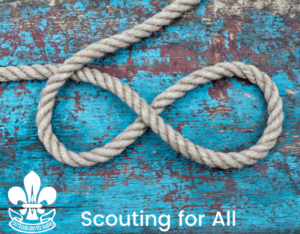Leader Guide to working with Scouts with Special Needs and Neurodiversity
 Part of our mission in OSG is to create “Scouting for All.” In this quest, we not only scout with people of all races, religions, backgrounds, genders, and orientations, but also with scouts who are neurodiverse and experience a variety of physical and learning challenges. While some of those differences make no difference to the scout leader or the program, as leaders, we may need extra skills to create an inclusive scouting program for youth who are atypical.
Part of our mission in OSG is to create “Scouting for All.” In this quest, we not only scout with people of all races, religions, backgrounds, genders, and orientations, but also with scouts who are neurodiverse and experience a variety of physical and learning challenges. While some of those differences make no difference to the scout leader or the program, as leaders, we may need extra skills to create an inclusive scouting program for youth who are atypical.
Inclusivity from the Start
If you have a scouting program with kids who are neurodiverse or have a disability, you may be wondering what to do. First, it is important that the scout be included as much as possible without being singled out. This means that if one scout needs to work on their knots with a larger rope, then everyone should have a larger rope! The larger rope is easier to hold than a thinner rope, so let them all use it.
Choosing activities where everyone can participate, snacks everyone can eat, and games everyone can play will help you build your group and let everyone play the game of scouting! Yes, this can mean you need to plan ahead to adjust for the scouts in your group, but you can do it! Scout the kids you have, not the kids you thought you’d have!
Addressing a Wide Range of Situations
With that said, it can be hard to know how and what to adjust for different challenges if you are new to working with atypical youth. This leader guide is here to help. While it does not cover every possible challenge, it has ideas for many specific and general ways to adapt to work with both your entire group and your specific scout with challenges.
The guide has been put together by a team of OSG leaders with a wide variety of experiences with atypical youth. It includes pages devoted to specific challenges like ADHD, autism, motor control issues, hearing loss, communication challenges, and dyslexia. It also has advice on how to adapt badges for scouts, so that they are stretching to meet a challenge, not discouraged they can’t do the impossible.
Last, this new guide ends with a section about how to create an Individualized Scouting Plan, ISP, for your scout. While every scout with a challenge may not need a written plan, creating one can help caregivers, parents, leaders, and scouts to all be on the same page and have a plan in place to meet a scout’s needs. Making a plan together can let you figure out how to adapt your plans for camping or other activities in advance so that you all have the best experiences possible.
Where to Get It!
You can download and read or print the leader guide here.
You can also download just the ISP form here.
If you need more help after reading the guide please reach out to me for further ideas at southregionbpsa@gmail.com or comment on our Outdoor Service Guides Special Needs Facebook group for help from our community.
